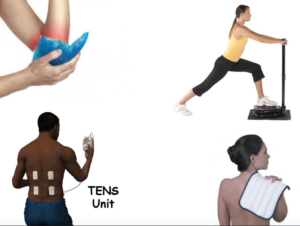by Mitch Hauschildt, MA, ATC, CSCS
We typically think of distractions as being a bad thing. They keep us from being productive and accomplishing things when and how we want to.
In our world today, we are bombarded with distractions. Our devices are constantly pulling at our focus. Our kids and their activities stretch us in immeasurable ways. And, our entertainment options create it’s own set of distractions.
In the COVID-19 era that we are currently living in, most of us are being distracted in very new and challenging ways. Personally, I have moved into the role of teacher for my 4 kids as well as housekeeper, chef, and other things while I simultaneously attempt to reinvent the way that I work. The distractions are seemingly endless and tricky to deal with.
But, distractions don’t always have to be negative. In the therapy world, we can use distractions to our advantage. When someone is in pain or feeling threatened neurologically, we can use distractions to help them move around those issues.
When someone has an injury or dysfunction, many times the brain will be hyper-focused on that problem. The brain’s flashlight is shining brightly on that problem. If we stay focused on that issue, moving beyond that issue will be difficult.
We have a number of modalities and strategies for moving past these problems, but one of them that many of us don’t use well enough (self included), is distraction therapy.
The roots of distraction therapy comes from the pediatric world. With kids, research has shown that if you place something colorful and cold on the skin at the same time that an injection is given, the patient experiences less pain and also has reduced rates of flare ups. By pulling the brain’s attention away from the insult to the system, there are a lot of positive things that occur.
The same is true of our musculoskeletal rehab programs and movement progressions. When we perform strength exercises, oftentimes our brain gives us a pain output or a decrease in strength or range of motion. This threat signal prevents things from moving forward.
One way to downregulate the threat signal is to distract the brain from that problem. How you ask? There are a lot of ways to do this. Here are just a few:
- Temperature change: Using things like heat and cold on the area of the body will stimulate the mechanoreceptors that can distract the brain from the nociception (pain) signals. This is a simple, accessible solution for a lot of us.
- Electrical Stimulation: While I don’t use E-stim a ton, it can be an easy way to distract the nervous system. It oftentimes works well to hook a patient up and then get them moving. The stimulation that they feel will distract the nervous system from their pain.
- Topical Analgesics: This is a chemical approach to accomplish the same thing as the the temperature change. Topical analgesics create this same heat and cold sensation, but through a different mechanism. These are also and easy and accessible approach to distraction therapy.
- Compression: Compression garments can distract the brain and result in a change in how we feel about an area of the body. This can be things like floss bands, but also compression clothing such as sleeves, shorts and shirts.
- Vibration: This is my favorite distraction means, if you have access to vibration. Thankfully, vibration is more accessible than ever with some great tools like vibrating balls, rollers and percussion massagers. I find that whole body vibration, such as PowerPlate works be the best, but for use in specific areas, these smaller units work well also.
Clinically, I have had a number of shoulder patients who can’t perform a PNF pattern or overhead activity under a load. But, when standing on a vibration platform or when holding a vibrating ball, the outcomes change significantly. This allows us to repattern poor movement patterns and progress them over time. And, the same can be seen with low back pain, knee pain and so on. It takes come creativity but it can be done.
Use any or all of these distractions to help improve how people move and feel.


This is great! Thanks for sharing this!